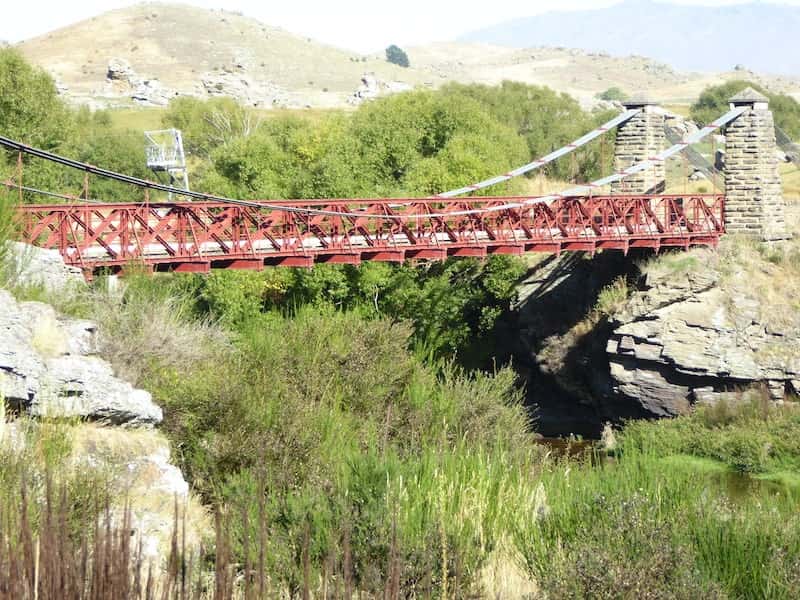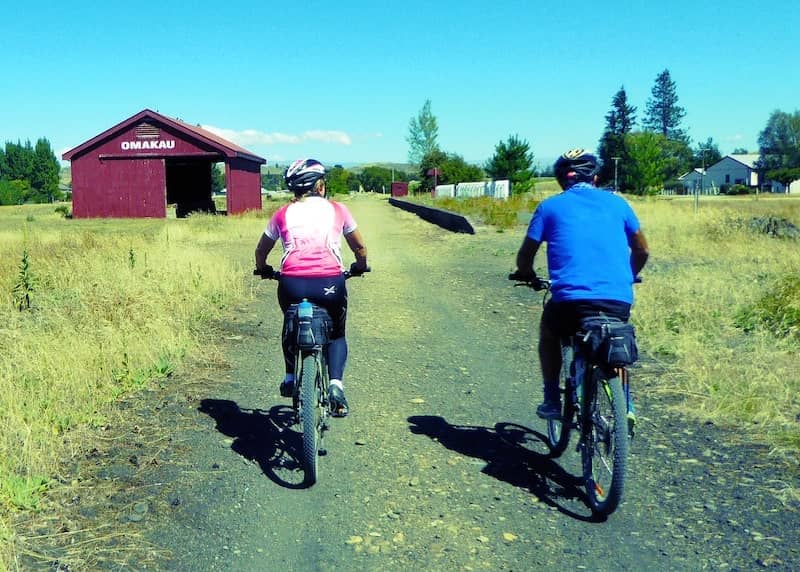For an exhilarating experience, hike or cycle Otago Central Rail Trail. Opened in 2000, New Zealand’s Original Great Ride is the 152-kilometre Otago Central Rail Trail. The pioneering ride follows the route of the former Otago Central branch railway from Clyde to Middlemarch in the Otago region of New Zealand’s South Island.
The classic approach is to take three or four days to cycle the entire trail, with short side trips to nearby townships and historic sites. Dedicated businesses have emerged in the last 20 years to provide services to the 15,000 riders who cycle the entire length of the trail each year. These, and older businesses, owe their survival to the trail.
Many more users hike or ride specific sections.
Cycle Otago Central Rail Trail
Our group planned several cycling experiences as part of our trip to New Zealand. We were a group of eight sexagenarians from Australia and Canada. Therefore, it made sense to book with a tour planner to provide bike rentals, shuttle services, and tour planning for two of the rides.
We chose two self-directed tours with Bike It Now: the combined three-day Roxburgh Gorge and Clutha Gold trails, and the ‘One Day Wonder Tour’ on a section of the Otago Central Rail Trail. The Clyde-based company offered a choice of three one-day rides on the rail trail. We chose the Poolburn Gorge section starting in Auripo with a choice of ending in Chatto Creek (30 kilometres) or Alexandra (47 kilometres).
The latter would provide us with a delightful taste of the trail, the first of its kind in New Zealand. With a maximum gradient of 2% for the steam trains, both inclines and declines made for leisurely cycling. Starting in Auripo meant that most of the trail was flat or downhill.
A brief history of the trail
It took labourers working with picks, shovels, explosives, and horse-drawn wagons to build the Middlemarch to Clyde railway line between 1891 and 1907. Steam trains chugged along this route for 83 years on a narrow-gauge track of 3 feet 6 inches.
By the 1930s, the economic boom was over, and the demise of the railway in sight. The construction of the hydroelectric dam at Clyde kept the railway open during the 1980s. By this time, roads had improved, and freight was being trucked by road. The railway tracks were dismantled when the line was officially closed in 1990.
The resultant long winding path through Central Otago became a perfect trail for cyclists. Opened in 2000, it was New Zealand’s first off-road cycleway.
Historic village of Clyde
Clyde, like many towns in Otago’s gold rush days, sprang to life in the 1860s. The town centre has retained many heritage buildings and quaint colonial cottages.
Arriving the day before meant time to wander around Clyde, grab a meal, and get outfitted with bikes and gear.
Our accommodation in Clyde was at the Antique Lodge Motel. It was within walking distance of Bike It Now and included free parking while we were cycling.
Shuttle service from Clyde to Auripo
On the way up to Auripo, our shuttle van crossed the Daniel O’Connell Bridge (1880) over the Manuherekia River and stopped at the Ophir Historic Township.
We could have biked to Ophir from Omakau on the Otago Central Rail Trail, a two-kilometre side trip. Stopping on the way to Auripo suited us, giving us a chance to wander through this single-street town. Its proximity to the trail has helped keep it and its history alive.
Founded in 1863, Ophir was an important commercial centre that fell into decline when gold dried up and the railway bypassed it in 1904. Many historic buildings remain, including New Zealand’s oldest continuously operating post office since 1886.
The Poolburn Gorge section of the trail
The Poolburn Gorge is an impressive section of the Otago Central Rail Trail. The trail cuts through the Raggedy Range separating the Manukerikia and Ida Valleys. It includes the 37-metre-high Poolburn Viaduct, two tunnels, and the trail’s longest bridge. It’s the most popular part of the trail, with around 24,000 users each year.
One of the two tunnels in the Poolburn Gorge section is Tunnel No. 13 (Poolburn No. 2), a curved structure 226 metres in length. The tunnels were cut by blasting through the schist rock and building a brick lining at each end. There’s no lighting, and cyclists are asked to walk their bikes. It helps to have a flashlight for safety, to observe the rocky walls, and imagine the effort it took to build the tunnels without machinery.
The 110-metre Manuherikia No.1 Bridge is the longest bridge on the trail. Completed in 1903, it’s built on concrete pillars and curves away into the distance.
The landscape of Poolburn Gorge is rocky and dry, affected by the typical Central Otago climate of dry hot summers and cold winters.
The trail is open all year round; we rode in the hot, dry month of February.
Verbascum thapsus (woolly mullein), an introduced species from Europe, thrives in the poor soil and climatic extremes.
After the gorge, the countryside became flatter as we cycled towards Lauder.
We encountered way more cyclists on this trail than on the Roxburgh Gorge and Clutha Gold trails. The Otago Central Rail Trail has energized several townships that had sprung up to accommodate the influx of people to the region after the discovery of gold in 1861. As a result, there are plenty of cafés and old hotels beside the old railway line, perfect places to stop for refreshments and find overnight accommodation.
The ever-changing scenery includes pastoral landscapes, lush valleys and river flats, steep gorges, character-rich townships, gangers’ sheds, and views stretching to distant hills and mountains. Irrigation pipes and roads, including the Muddy Creek Road, crossed above the trail, adding interest to the ride.
We appreciated Otago’s legendary big skies.
It was a slight downhill ride through farmland towards Omakau. Omakau, meaning ‘Belonging to Husband & Wife,’ is a small country township where an old railway goods shed stands as a shelter beside the old Omakau station and siding. It was one of the busiest stock loading stations in New Zealand. Homemade pies are available at the café or grab a cold beverage at the old country pub.
Only in New Zealand!! This friendly guy seemed to love bicycles and pats from cyclists.
The deer, sheep, and cattle stations get a much-needed boost from irrigation.
The original section of the Chatto Creek Tavern was built in 1886 as a stopover on the Cobb & Co. coach route. Today, it is a popular stop on the trail. Head inside for refreshments, take a break in the rest area, or check out New Zealand’s smallest Post Office (1892-1975) in the yard.
The significance of the Otago Central Rail Trail
Riding our home stretch towards Alexandra offered the space to reflect on the significance of the trail. Its history was grounded in the gold rush days, but more recent initiatives were focussed on not letting such a vital resource go to waste.
Inspired by the rail-to-trails movement gaining traction elsewhere, New Zealand visionaries saw the potential of the old Clyde-to-Middlemarch railway corridor. A trust was established to manage the process, and it soon attracted hlkers, cyclists, and horse riders to immerse themselves in the history and scenery of the region. After the last train whistle shrilled down the track in 1990, another industry took root.
It brought economic benefits and helped preserve the history of the region.
The Otago Central Rail Trail became the inspiration for other initiatives to tap into the cycling revolution and the creation of the New Zealand Cycle Trail network.
I was surprised to learn that the average age of cyclists on the trail is 56 or 57.
What to pack
Temperatures during a Central Otago summer can be hot, and there’s not a lot of shade on the trail. Our bikes were fitted with water bottle cages and rear pannier trunk bags, so carrying what we needed was easily managed for a 47-kilometre ride.
Based on our experience, here are my suggestions for a similar ride:
- two full water bottles, refillable at cafés and pubs
- plan to support local businesses for meals and breaks, but carry snacks such as fruit and energy bars
- sunscreen, sunhat, and sunglasses
- chill sleeves for sun protection
- first-aid kit, and personal medication
- toilet paper
- hand sanitizer
- flashlight for tunnels
- season-specific clothing for layering
- waterproof rain gear
- cycling gloves, helmet
- closed-toe footwear
- puncture repair kit
- camera
- cell phone
If you found this post helpful, please share it by selecting one or more social media buttons. Is New Zealand on your travel list? If so, might you be interested in my other posts on New Zealand?
- Hike or cycle New Zealand’s Clutha Gold Trail
- Hike or cycle New Zealand’s Roxburgh Gorge Trail
- The controversial story of New Zealand’s quirky bra fence
- For amazing scenery, cycle New Zealand’s Queenstown Trail
- While in New Zealand, don’t miss the dolphin-spotting dogs of Akaroa
- An extinct volcano and penguin conservation: hike New Zealand’s Banks Track
- The best way to see New Zealand’s Milford Sound
Pin it for later?





















Looks like a great cycling adventure with some historical scenery along the route.